I have made a 'grammar pack' for the German language based on the grammar guide
at LingQ. The pack consists of three things. They are:
- a book
- a pack of (playing) cards
- a collection of desktop wallpapers/backgrounds.
You can download them all using the link at the end of this page. I must
stress here, though, this pack is a prototype. So, you should expect
spelling errors, alignment problems and other unforeseen mistakes.
Before getting too far in to this overview, I though it would be a good idea to
explain what/who LingQ is/are. With that said, I don't want to put words into
their month. So, here is how LingQ describe themselves,
LingQ is a fun, simple way to learn languages from authentic, interesting
content. Learning the language from the language itself, just as most children
learn their own language.
If you would like to know more about them, there is a link at the bottom which
will take you to their website. Also, I am not associated with them in any
way. I'm a customer and nothing more.
I decided to make this collection of 'toys' for two reasons. The first is
because I haven't done a graphic design project in a long time which was getting
to me. The second one is because I wanted a way to exposed myself to the German
grammar rules in a passive way. If you haven't guessed yet, I'm using LingQ to
learn German. So, I will need to know how the grammar works if I want to reach a
reasonable level.
As I stated above, this version of the grammar pack is a prototype -- the second
prototype actually. Because of this, I've based the designs on what I need/want
with the hardware/tools available to me. So, the wallpapers might not sit well
on your screen, the front cover/book might be unprintable.
The Book
On LingQ's website, they have a grammar guide alongside the languages they offer
(German in my case). So, I've taken the German guide and arranged it into a book
(for myself first and foremost). I did this because I don't like sitting at my
computer all the time for reading.
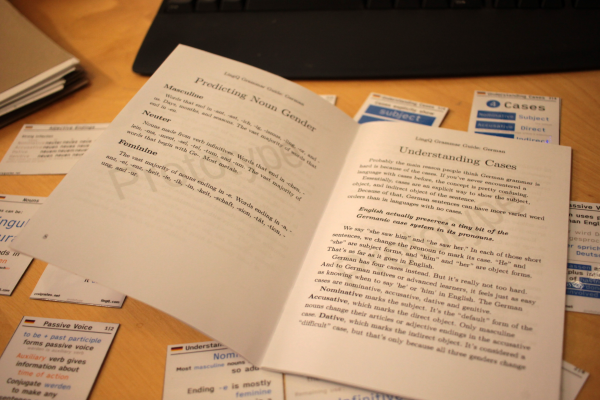 LingQ Grammar Guide Book 1.
LingQ Grammar Guide Book 1.
The book itself is A5 and about forty sides (twenty pages) long -- when printed,
folded and stapled together. The layout of the text means you will need a
double-sided A4 printer. If you haven't got one, you can print all the odd pages
first and then print all the even pages on the reverse-side. Unfortunately, each
printer is different so you might need to play around with yours. I printed mine
on 80 gsm cartridge paper. The finish is not the best but it's good enough.
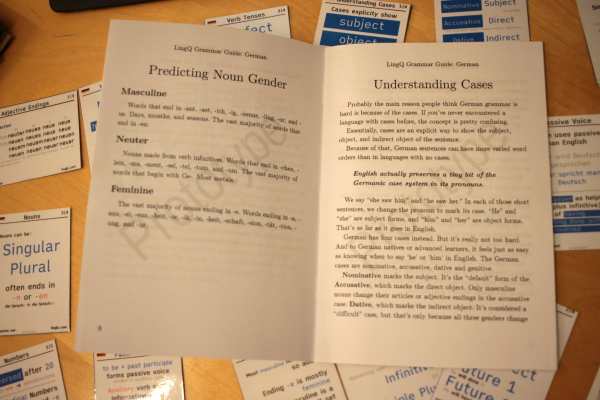 LingQ Grammar Guide Book 2.
LingQ Grammar Guide Book 2.
When you have everything printed, you will need to bind it. I did this using a
long-arm stapler. There are other ways you can bind it but that is something
beyond the scope of this overview. Instead, I will leave a link at the bottom
for a quick guide, by WikiHow, to get you started.
The front cover is a novel feature. You don't need it but the book does feel
fancy with it. To print it, you will need an A3 printer. If you don't have
one, you can print the first page of the book on some card or leave it out. The
content in the book is the most important thing. I printed my front cover on 250
gsm glossy photo paper which made it quite sturdy and the text is sharp. With
that said, feel free to use whatever paper you prefer.
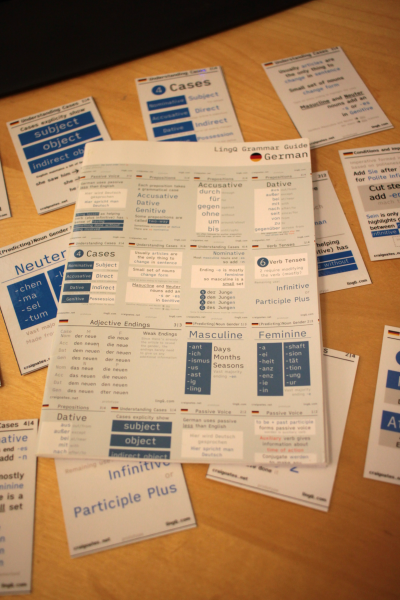 LingQ Grammar Guide Book Cover.
LingQ Grammar Guide Book Cover.
I will end this section by saying the front cover is not my finest work. It's
very rough and the trimmarks are a little under 10 mm off -- even when printed
at 100% scale. I did this because it's a prototype and wanted some wriggle-room
and my maths is rubbish. For a nice (nicer) finish, trim the bound book
(including the front cover) on a (good) guillotine. Also, make sure the printer
is not set to 'fit to page', it must be '100%'.
Playing Cards
The cards are nothing more than a reduced version of the book. Some of the cards
will not make sense unless you've read the book/actual grammar guide. My
intention with these was to have a way to expose the grammar guide to me in a
passive manner. I can't read the book all the time and I won't have the book
with me at all times, either.
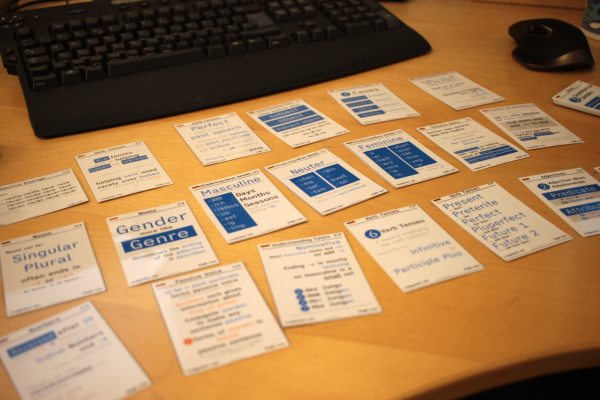 Printed playcards which I've laminated.
Printed playcards which I've laminated.
The design of the cards allows you to have a front and a back if you want. This
is easier if you have a (A4) printer which does double-sided printing but it's
not essential. I've marked all the front-facing designs with an 'a' and the
back-facing ones with 'b' in the filenames. So,
'lingq-printing-sheet-1a-p2.png' is the front and
'lingq-printing-sheet-1b-p2.png' is the back. If you can't do a
double-sided print, print the 'a' sides first and then flip them around and
print the 'b' sides on the back. You will find they don't line up as well but
they should be close enough for you to use them.
I printed my cards on 160 gsm matt card and laminated them with pouches 60
micron thick. I did a few tests using thicker paper and laminate pouches and
they are more robust. With that said, my current set-up is fine. They don't feel
like they're going to fall apart any time soon.
Desktop Wallpapers/Backgrounds
The wallpaper designs are an extension of the playing cards. They are another
way for me to expose myself to the German language and its rules in a passive
manner.
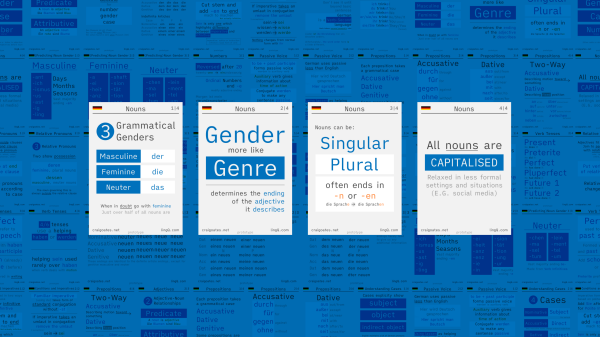 An example of how the desktop wallpapers look.
An example of how the desktop wallpapers look.
As an aside, I use 'wallpaper' and 'background' interchangeably. So, if say
'desktop wallpaper' and it makes no sense, replace 'wallpaper' with
'background'.
This project's main purpose is to help me learn German grammar. Because of
this, the set of wallpapers I've created are all in one size (2560x1440
px). This is the screensize I use the most so I made sure the designs fit that
the best. I've found, though, if you set your wallpaper to 'scaled', they should
look okay on most widescreen monitors. Unfortunately, each operating system has
a different way of setting their wallpapers. So, I'm gonna have to leave you
hanging with regards to showing you how to change you wallpaper.
File Breakdown
The grammar pack comes as a .zip file so you need to unzip it after you've
downloaded it. This should be a case of right-clicking on the file and selecting
something along the lines of '7-Zip -> Extract Here'. Again, each operating
system is different in this regard so, if you're unsure, you might need to
look-up how to do it.
After you have unzipped the file, you will find the following file
structure,
lingq-german-p2
├── wallpapers
│ ├── desktop-wallpaper-p2-4-verb-tenses.png
│ ├── desktop-wallpaper-p2-4-understanding-cases.png
│ ├── desktop-wallpaper-p2-4-subjunctive.png
│ ├── desktop-wallpaper-p2-4-seperable-and-inseperable-prefix-verbs.png
│ ├── desktop-wallpaper-p2-4-relative-pronouns.png
│ ├── desktop-wallpaper-p2-4-prepositions.png
│ ├── desktop-wallpaper-p2-4-passive-voice.png
│ ├── desktop-wallpaper-p2-4-numbers.png
│ ├── desktop-wallpaper-p2-4-nouns.png
│ ├── desktop-wallpaper-p2-4-nouns-gender.png
│ ├── desktop-wallpaper-p2-4-intro-to-verbs.png
│ ├── desktop-wallpaper-p2-4-constructing-sentences.png
│ ├── desktop-wallpaper-p2-4-conditions-and-imperatives.png
│ ├── desktop-wallpaper-p2-4-articles.png
│ ├── desktop-wallpaper-p2-4-adjectives.png
│ ├── desktop-wallpaper-base-p2-3.png
│ ├── desktop-wallpaper-base-p2-2.png
│ └── desktop-wallpaper-base-p2-1.png
├── playing-cards
│ ├── lingq-printing-sheet-5b-p2.png
│ ├── lingq-printing-sheet-5a-p2.png
│ ├── lingq-printing-sheet-4b-p2.png
│ ├── lingq-printing-sheet-4a-p2.png
│ ├── lingq-printing-sheet-3b-p2.png
│ ├── lingq-printing-sheet-3a-p2.png
│ ├── lingq-printing-sheet-2b-p2.png
│ ├── lingq-printing-sheet-2a-p2.png
│ ├── lingq-printing-sheet-1b-p2.png
│ └── lingq-printing-sheet-1a-p2.png
└── book
├── lingq-german-grammar-guide-p2.3.pdf
├── lingq-german-grammar-guide-p2.3-1.pdf (for single-sided printing)
└── lingq-german-grammar-guide-front-cover-p2.1.png
Within the 'lingq-german-p2' folder, there are three folders:
- book
- playing cards
- wallpapers
Within those folders are the files relating to those 'mini-projects'. At this
point, it is a case of opening the files and seeing what's in there.
If you're struggling with any of the above, I've created a thread in LingQ's
forums. So, feel free to head over to that and ask any questions you have. The
link (like the rest of them) is below.
Last of all, I, again, can't stress this enough: the designs included here are
all prototypes. And, more importantly, they are aimed at solving my problems
first-and-foremost. The people I expect to find the most use from everything
listed above are people who like to tinker and make things. I wouldn't be
surprised if people used these files as nothing more than a starting-point for
their own projects. Everything included here is incomplete and requires you to
have reasonable computer skills. The designs are not 'finished products'. With
that said, I don't want to discourage people from wanting to learn and make
things. So, if you're wanting to improve your computer/design/making skills, I
think this is a good project to try your hand at.
Links
The images below are a selection of the project's files to give you an example
of what the designs look like. Download the 'lingq-german-p2.zip' file above to see
all the files.
�����������������������������������������������������������������������������������������������������������������������������������������������������������������������������������������������������������������������������������������������������������������������������������������������������������������������������